| Author |
Message |
|
Tor G.
|
 Posted: Fri 03 Aug, 2018 8:26 pm Post subject: Greek Thigh Armor (Archaic Greece) Posted: Fri 03 Aug, 2018 8:26 pm Post subject: Greek Thigh Armor (Archaic Greece) |
 |
|
I've been looking a while for depictions of greek thigh guards from the archaic period, but I can't seem to find any photos.
Can someone help me to some photos? Where am I supposed to look?
This is the only thing I've found that comes even close, but I don't even know what's around their thighs (the spirals).


|
|
  |
 |
|
Sean Manning
|
 Posted: Sat 04 Aug, 2018 1:13 am Post subject: Posted: Sat 04 Aug, 2018 1:13 am Post subject: |
 |
|
|
Have you checked Connolly's Greece and Rome at War and Van Wees' Greek Warfare: Myths and Realities? Pretty soon after that you will need books which are only available in big university libraries like Eo Jarva's Archaiologica on Archaic Greek Body Armour and reports from the excavations at Olympia, but Connolly and van Wees will get you started.
|
|
  |
 |
Mikko Kuusirati

|
 Posted: Sat 04 Aug, 2018 2:21 am Post subject: Posted: Sat 04 Aug, 2018 2:21 am Post subject: |
 |
|
I actually have Archaiologia, I'll take a look when I get home and scan whatever photos it has. Just don't hold your breath, it's a bit sparse on images. Lots of references to specific finds and pieces of period art, though, which should also help.
"And sin, young man, is when you treat people like things. Including yourself. That's what sin is."
— Terry Pratchett, Carpe Jugulum
|
|
  |
 |
|
Matthew Amt
|
 Posted: Sat 04 Aug, 2018 7:10 am Post subject: Posted: Sat 04 Aug, 2018 7:10 am Post subject: |
 |
|
Yeah, I'd say the ones you show with spirals on the thighs are thigh guards. On the first one I believe you can discern the top and side edges, even. There are certainly more depictions that are at least a little less ambiguous, though it would take some digging through a number of books to track them down. As has been said, Connolly is a good place to start, he'll even show a surviving example or two.
A little googling turned up a surprising depiction on a red-figure vase!

Even shows holes along the edge for the lining! It doesn't get much better than that.
Gah, image not working?? Try this, first image:
https://en.wikipedia.org/wiki/Andokides_painter
Matthew
|
|
   |
 |
|
Tor G.
|
 Posted: Sat 04 Aug, 2018 8:38 am Post subject: Posted: Sat 04 Aug, 2018 8:38 am Post subject: |
 |
|
| Matthew Amt wrote: | Yeah, I'd say the ones you show with spirals on the thighs are thigh guards. On the first one I believe you can discern the top and side edges, even. There are certainly more depictions that are at least a little less ambiguous, though it would take some digging through a number of books to track them down. As has been said, Connolly is a good place to start, he'll even show a surviving example or two.
A little googling turned up a surprising depiction on a red-figure vase!

Even shows holes along the edge for the lining! It doesn't get much better than that.
Gah, image not working?? Try this, first image:
https://en.wikipedia.org/wiki/Andokides_painter
Matthew |
I have the greece and rome at war book. As far as I know, in it they show 2-3 images of thigh guards. In it they state that only one thigh guard has been found, but it's not the type of thigh guard other images show. It's more of an extension to the greave. Then they show it being worn, but I'm not entirely sure how it's fastened as they only show the front.
Later in the book there is more of a clear picture of what a thigh guard would look like, but they don't seem to match what the greek images look like. Like the greaves, there is a space separating the sides.
In the book, which shows etruscan warriors wearing greek armor, this space is on the inside of the thigh. Whenever I look at greek thigh guards that space seems to be on the backside.. if it is even present.
On the image you posted (which I am grateful for), that space doesn't seem to be there (and the thigh guard is much longer).
Here's another image of the space looking like it's on the backside (which is where I would put it, but I don't know how that would turn out when wearing it).

Last edited by Tor G. on Sat 04 Aug, 2018 8:50 am; edited 1 time in total
|
|
  |
 |
|
Tor G.
|
 Posted: Sat 04 Aug, 2018 8:46 am Post subject: Posted: Sat 04 Aug, 2018 8:46 am Post subject: |
 |
|
| Sean Manning wrote: | | Have you checked Connolly's Greece and Rome at War and Van Wees' Greek Warfare: Myths and Realities? Pretty soon after that you will need books which are only available in big university libraries like Eo Jarva's Archaiologica on Archaic Greek Body Armour and reports from the excavations at Olympia, but Connolly and van Wees will get you started. |
As I said to Matthew, I have the first of those books, but I'm not entirely sure of what to make of it. I feel a bit hesitant to buy a book for just a image of a thigh guard (however, I appreciate your guidance on where to find it). It might be a last option.
The rest of the books I doubt I'll be able to get a hold of.
Thank you.
| Mikko Kuusirati wrote: | | I actually have Archaiologia, I'll take a look when I get home and scan whatever photos it has. Just don't hold your breath, it's a bit sparse on images. Lots of references to specific finds and pieces of period art, though, which should also help. |
Thanks for taking the time.
|
|
  |
 |
Mikko Kuusirati

|
 Posted: Sun 05 Aug, 2018 5:46 am Post subject: Posted: Sun 05 Aug, 2018 5:46 am Post subject: |
 |
|
OK, so. "Archaiologia on Archaic Greek Body Armor", Eero Jarva, 1995.
I must not have looked at it in some time, as it's actually rather more thoroughly illustrated than I recalled! (Also, after a glance around online I'm a bit gobsmacked that it seems to go for $200 everywhere, having bought mine for a tenth of that at a second hand book store.  ) )
| Quote: | 4. Protection of the legs
a) Thigh guards
The extant evidence on the use of thigh guards in Archaic Greece is composed of a relatively numerous group of representations in art from different geographical areas, but there is only one original guard in bronze, which clearly stands out typologically from the other material. Altogether the evidence shows that several types of thigh guard were in use, classified here into five types (I-V), but the majority of the Attic representations cannot be classified typologically, although it is probable that they should be seen mainly as reflections of the most common type (IV). (...) The artistic evidence for thigh guards is concentrated almost exclusively in the sixth century, with only a few Attic vase paintings from the very beginning of the fifth century. Geographically, this material comes mainly from Attika, with evidence from the Peloponnese (Corinth and Sparta), and a silver figurine mentioned by Lorimer seems to be the only example coming from outside the mainland. (...)
Type I
The only original thigh guard from Olympia (Br9097, Fig. 36) is 24cm high and its vertical edges are provided with additional holes intended for lacing in the same way as is regularly the case with the 'Prototype' greaves, to which this is also connected by the pronounced modelling of the muscles and the kneecap (...) suggesting a date in the first half of the seventh century.
Type II
On a few relief pithos fragments found at Sparta and in its neighbourhood the protagonist on the right, fighting over a fallen warrior, is provided with long thigh guards (Fig. 37). Along the mid-thigh, both inside and outside, there are small crosses, which probably rightly have been seen as indications of lacing on both sides. (...) The close-fitting aspect and the great length may signify that non-metallic material was intended on the Spartan relief vases (...) which are dated to about 575 (...)
Type III
This type is a medium long thigh guard provided with a seam on the inner side of the thighs. The evidence is not much more plentiful than for the preceding types, being for practical purposes limited to a Corinthian pinax fragment in Berlin (Fig. 38), an Attic black-figure vase fragment by Lydos and the thigh guards represented on a late Archaic terracotta from the temple of Mater Matuta at Satricum (Italy). (...) The structural features and the fact that we can trace type III in both Corinth and Athens suggest that thigh guards of this kind really were worn by soldiers in the course of the first half of the sixth century, maybe most probably during the second quarter. (...)
Type IV
It is characteristic of this type that the guards are medium long and that they open at the back. One of the earliest clear representations of this type appears on the bronze warrior figurine at Longa in Messenia (Fig. 6), datable to the third quarter of the sixth century. (...) The Attic representations of this type (Fig. 39) differ from the Longa figurine mainly in two details: the upper and lower edges are drawn with a wavy line so that in some cases they look very much like those on the Spartan reliefs discussed above, while on the other hand the spiral decorations on them are more freely set, often tending to be in an oblique position. This type makes its decisive appearance on Attic black-figure vases in the production of Exekias in the 540's and 530's and on an oinochoe in Berlin painted by Lydos in his late career. (...) The structural features of this type are very clear in many representations and can probably be interpreted as evidence that thigh guards of this kind were really seen in Athens, at least soon after the mid-sixth century. (...) The end of the Attic representations of thigh guards comes during the first quarter of the fifth century on some late black-figure vases, where again only spirals indicate their presence, a feature which begins to be seen already around 510 or slightly earlier. The thigh guards did not interest the red-figure artists, as may be deduced from the very few representations left by them. This fact together with the 'degenerated' black-figure representations suggest that this type of thigh guards fell out of use in Athens at the latest by the beginning of the fifth century.
(Catalogue of Attic vases with representations of thigh guards omitted because damn that's a lot to type!)
Type V
On a Tyrrhenian amphora by the Kyllenios Painter in London there is a warrior whose thigh guards differ from the types described above. The drawing, as is usual on the vases of this group, is not very accurate but incised lines on the thighs show that the painter has represented relatively short thigh guards in which the opening has rounded edges, probably on the inner side, although this scene represents an opening on the outside of the right thigh, too. Such thigh guards have closely parallel cases on architectonic terracottas from Central Italy, in a columen relief from the Latial side of Satricum and in an akroterion group from the Faliscan city of Falerii (Fig. 40), both datable around 500 or slightly later. (...) We can see that the guard in the Falerii relief is laced for fastening. The structural similarity to the arm guards discussed above and some later monuments seem to witness that this type was firmly rooted in Central Italy at least from the end of the Archaic Period onwards. Regarding the origin of this type, we must ask whether it is basically Etrusco-Italic or Greek. (...)
There is a bronze sheet in the Vatican (Fig. 41) where there are also vertical bands on the thighs of a warrior, and these are decorated with small raised dots, which also reappear on his greaves, shield and the background of the figured decoration. The identification of the thigh guards in this case is somewhat problematic, but possibly correct. The plaque is part of a larger group dated to the third quarter of the seventh ventury by Salskov Roberts, according to whom the plaque originates from Southern Etruria and its style is influenced by Syro-Phoenician art. Quite similar segment-like bands can be seen also on Phrygian painted terracotta plaques from Pazarli in Anatolia, dated to the sixth century. The relatively wide geographical diffusion of the evidence regarding the band-like thigh guards and the fact that the Etruscan plaque is earliest in this heterogenous group, raises the question of whether such guards were Greek at all. (...) |
My scanner seems to be dead, but here's the best cellphone photos I could manage. Most of the pictures in Jarva's book are already reproduced from earlier publications, so unfortunately there's only so much I could do for image quality...
 Attachment: 137.55 KB Attachment: 137.55 KB
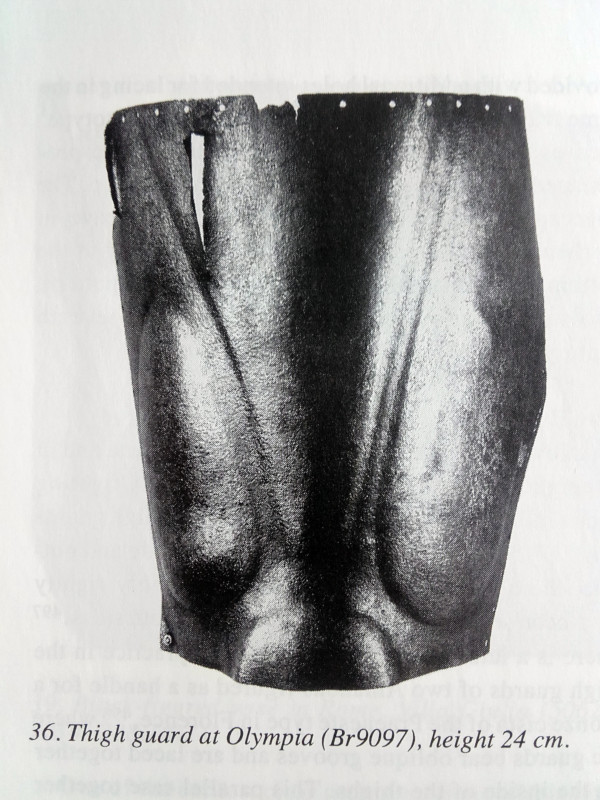
 Attachment: 171.83 KB Attachment: 171.83 KB
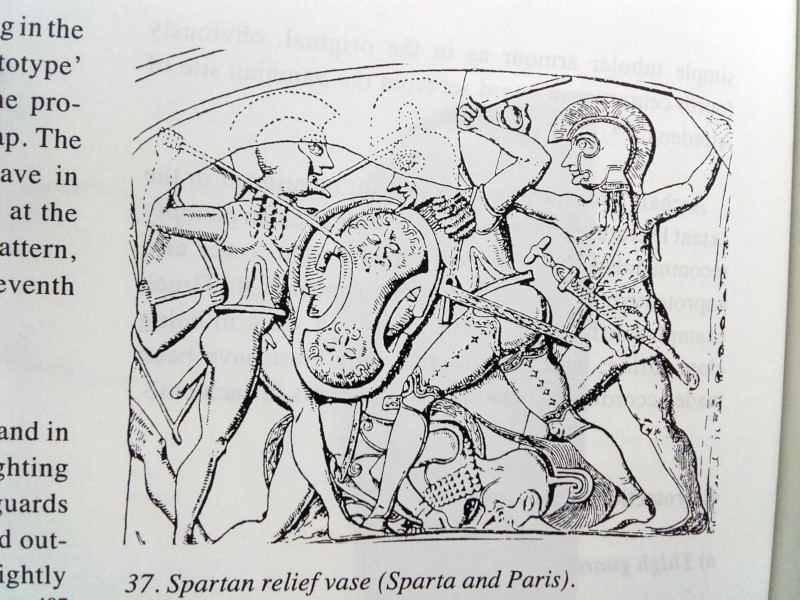
 Attachment: 165.91 KB Attachment: 165.91 KB
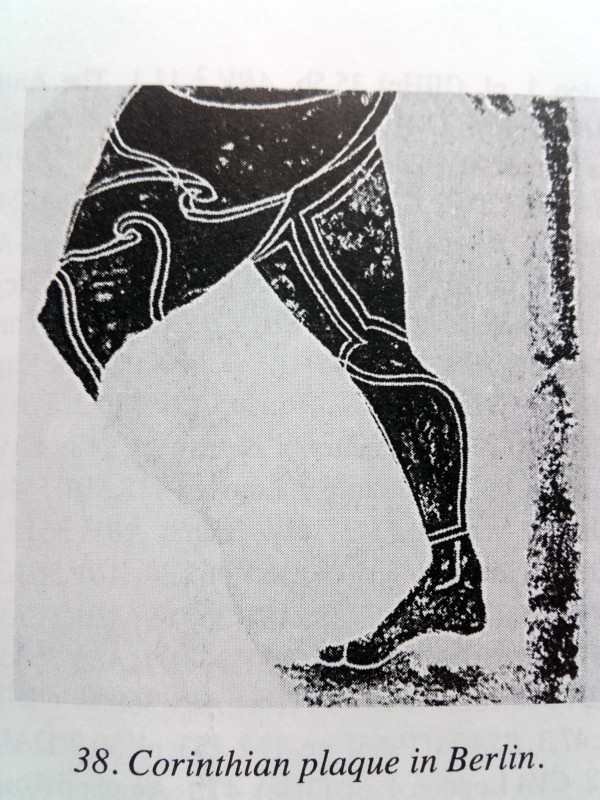
 Attachment: 140.41 KB Attachment: 140.41 KB

 Attachment: 160.56 KB Attachment: 160.56 KB
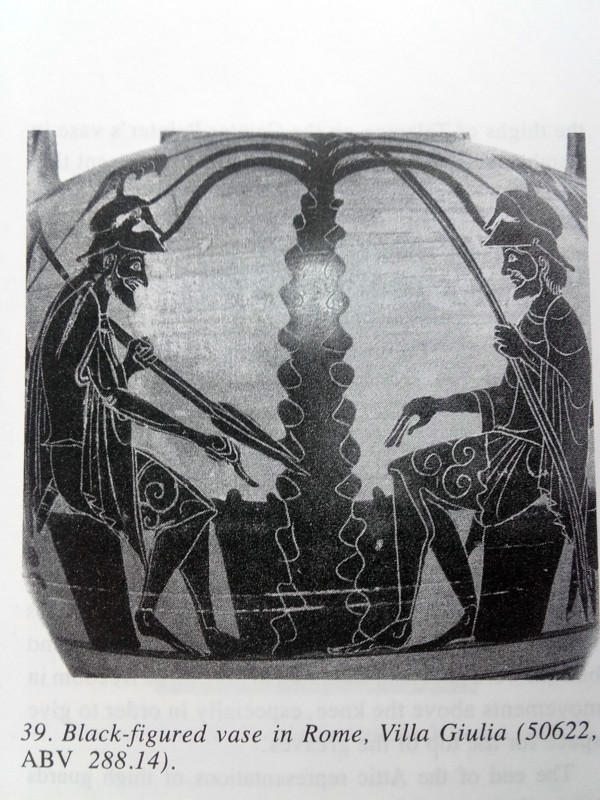
 Attachment: 132.63 KB Attachment: 132.63 KB
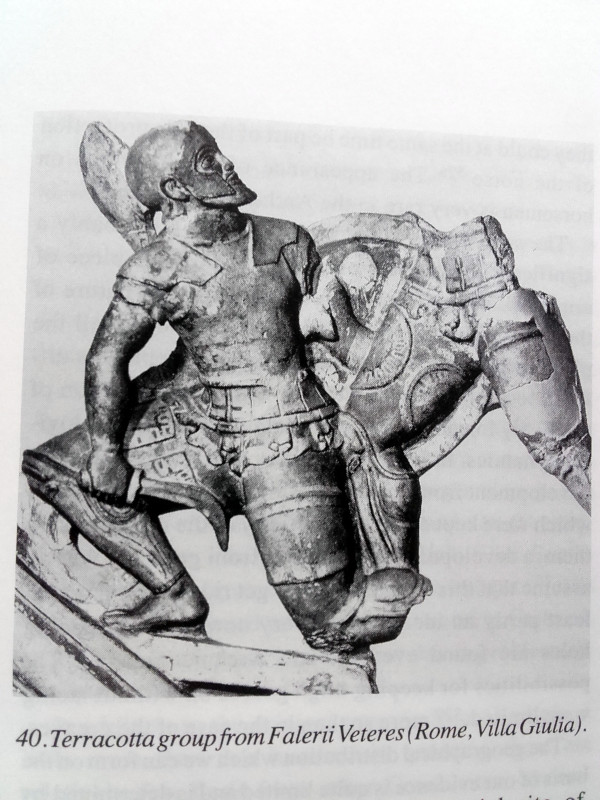
 Attachment: 140.91 KB Attachment: 140.91 KB
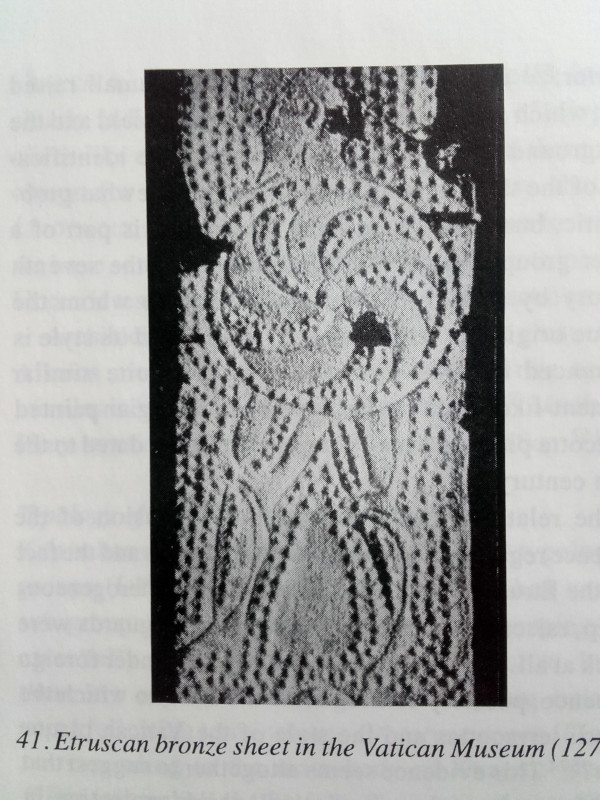
"And sin, young man, is when you treat people like things. Including yourself. That's what sin is."
— Terry Pratchett, Carpe Jugulum
Last edited by Mikko Kuusirati on Sun 05 Aug, 2018 6:02 am; edited 2 times in total
|
|
  |
 |
|
Matthew Amt
|
 Posted: Sun 05 Aug, 2018 5:54 am Post subject: Posted: Sun 05 Aug, 2018 5:54 am Post subject: |
 |
|
Well, *that's* a nice little gold mine! And I hadn't remembered that little figurine was wearing them. Thanks, Mikko!
Matthew
|
|
   |
 |
|
Sean Manning
|
 Posted: Sun 05 Aug, 2018 6:38 am Post subject: Posted: Sun 05 Aug, 2018 6:38 am Post subject: |
 |
|
| Mikko Kuusirati wrote: | OK, so. "Archaiologia on Archaic Greek Body Armor", Eero Jarva, 1995.
I must not have looked at it in some time, as it's actually rather more thoroughly illustrated than I recalled! (Also, after a glance around online I'm a bit gobsmacked that it seems to go for $200 everywhere, having bought mine for a tenth of that at a second hand book store.  ) ) |
Yes, it is one of those books where the publisher printed about 200 copies, several prestigious researchers cited it, and now everyone wants to read it but there are no copies. Sometimes academic publishers are just not ready for the possibility that people might actually want to read one of their books!
Now that we have the catalogue number, you can find the same photo of Br 9097 at http://arachne.uni-koeln.de/item/objekt/221145
|
|
  |
 |
|
Tor G.
|
 Posted: Sun 05 Aug, 2018 7:03 pm Post subject: Posted: Sun 05 Aug, 2018 7:03 pm Post subject: |
 |
|
| Mikko Kuusirati wrote: | OK, so. "Archaiologia on Archaic Greek Body Armor", Eero Jarva, 1995.
I must not have looked at it in some time, as it's actually rather more thoroughly illustrated than I recalled! (Also, after a glance around online I'm a bit gobsmacked that it seems to go for $200 everywhere, having bought mine for a tenth of that at a second hand book store.  ) )
....
|
This is great! The images are very clear imo. From my amateur view they all seem very similar with the fastening and length differ the most.
Thanks a lot. This information is very hard to come by. I have basically found nothing elsewhere, especially on the internet.
|
|
  |
 |
Dan Howard

|
 Posted: Sun 05 Aug, 2018 10:31 pm Post subject: Posted: Sun 05 Aug, 2018 10:31 pm Post subject: |
 |
|
| Tor G. wrote: | | Mikko Kuusirati wrote: | OK, so. "Archaiologia on Archaic Greek Body Armor", Eero Jarva, 1995.
I must not have looked at it in some time, as it's actually rather more thoroughly illustrated than I recalled! (Also, after a glance around online I'm a bit gobsmacked that it seems to go for $200 everywhere, having bought mine for a tenth of that at a second hand book store.  ) )
....
|
This is great! The images are very clear imo. From my amateur view they all seem very similar with the fastening and length differ the most.
Thanks a lot. This information is very hard to come by. I have basically found nothing elsewhere, especially on the internet. |
They all look very similar to me too. Jarva tried to create a false typology based almost entirely on illustrations. Meyrick showed us how silly that idea is with mail. Dawson vainly tried to do the same thing with Byzantine lamellar. Forget about the illustrations. We have a surviving example from Olympia so use that as the basis for a reconstruction.
Author: Bronze Age Military Equipment, Pen and Sword Books
|
|
  |
 |
|
Tor G.
|
 Posted: Mon 06 Aug, 2018 12:02 am Post subject: Posted: Mon 06 Aug, 2018 12:02 am Post subject: |
 |
|
| Dan Howard wrote: | | They all look very similar to me too. Jarva tried to create a false typology based almost entirely on illustrations. Meyrick showed us how silly that idea is with mail. Dawson vainly tried to do the same thing with Byzantine lamellar. Forget about the illustrations. We have a surviving example from Olympia so use that as the basis for a reconstruction. |
That's probably a good idea.
But imo if it's to look like the depictions, it would need another half on the back. Or at least it going further around.
I assume if it's two pieces they would be laced on some fabric which holds them together.
|
|
  |
 |
Dan Howard

|
 Posted: Mon 06 Aug, 2018 12:05 am Post subject: Posted: Mon 06 Aug, 2018 12:05 am Post subject: |
 |
|
When a piece of plate armour has a lot of holes around the edge it is usually for attaching a liner.
Author: Bronze Age Military Equipment, Pen and Sword Books
|
|
  |
 |
|
Tor G.
|
 Posted: Mon 06 Aug, 2018 12:25 am Post subject: Posted: Mon 06 Aug, 2018 12:25 am Post subject: |
 |
|
| Dan Howard wrote: | | When a piece of plate armour has a lot of holes around the edge it is usually for attaching a liner. |
Then how do you suggest it's fastened to the leg?
|
|
  |
 |
Mikko Kuusirati

|
 Posted: Mon 06 Aug, 2018 1:07 am Post subject: Posted: Mon 06 Aug, 2018 1:07 am Post subject: |
 |
|
| Tor G. wrote: | | Dan Howard wrote: | | When a piece of plate armour has a lot of holes around the edge it is usually for attaching a liner. |
Then how do you suggest it's fastened to the leg? |
The bronze guards seem to have been very closely fitted, so when they wrap around the limb they're held in place by the springiness of the metal (much like the associated arm and lower leg defenses). The opening, whether it's on the back or the inside of the thigh, should be narrow enough that you have to flex it open to insert the limb. There's also evidence of lacing on some contemporaneous lower leg and arm defenses, and a few representations in art show it on thigh guards as well. And of course laces could also be attached to the lining, leaving no trace on the metal.
And yeah, Dan's right, interpretation of artistic renditions should always be taken with a pinch of salt, especially with this almost complete absence or archaeological evidence to back it up. And as Jarva himself says, most depictions in period art defy categorization and should probably be assumed to be stylistic renditions of the most common type (medium length, opening at the back, may or may not have contoured upper and lower edges).
PS. Does anyone here read French? 
"And sin, young man, is when you treat people like things. Including yourself. That's what sin is."
— Terry Pratchett, Carpe Jugulum
|
|
  |
 |
Dan Howard

|
 Posted: Mon 06 Aug, 2018 1:39 am Post subject: Posted: Mon 06 Aug, 2018 1:39 am Post subject: |
 |
|
| Tor G. wrote: | | Dan Howard wrote: | | When a piece of plate armour has a lot of holes around the edge it is usually for attaching a liner. |
Then how do you suggest it's fastened to the leg? |
three ways:
The guard springs open to fit around the thigh and is held in place by the springiness of the metal, like later shin guards.
The guard is laced to the leg and the lacing is attached to the liner, not the metal.
Some pieces of armour have a few holes that are larger than the others. These are for lacing to the limb or for joining it to another piece of plate, not attaching a liner.
Author: Bronze Age Military Equipment, Pen and Sword Books
|
|
  |
 |
|
Tor G.
|
 Posted: Mon 06 Aug, 2018 4:37 am Post subject: Posted: Mon 06 Aug, 2018 4:37 am Post subject: |
 |
|
Ok, thanks for making it clear. I think I could make something decent out of this.
Btw, Mikko, I did look at the link. My french isn't very good at all, but with a little help from google translate they don't seem to fill us in on something new and moves quickly past it. If anyone actually speaks french, and this is wrong, please correct me. 
|
|
  |
 |
Mikko Kuusirati

|
 Posted: Mon 06 Aug, 2018 7:50 am Post subject: Posted: Mon 06 Aug, 2018 7:50 am Post subject: |
 |
|
Well, damn.
I really wish there was more information and in particular more oblique views available on this apparently unique artifact.
"And sin, young man, is when you treat people like things. Including yourself. That's what sin is."
— Terry Pratchett, Carpe Jugulum
|
|
  |
 |
|
Joe A
Location: Philadelphia, USA Joined: 17 Oct 2013
Posts: 89
|
 Posted: Mon 06 Aug, 2018 7:58 am Post subject: Posted: Mon 06 Aug, 2018 7:58 am Post subject: |
 |
|
Never thought much about thigh guards til now. Interesting discussion.
In the "Spartan Relief Vase" note that the very heavily armored Hoplite with the thigh guards is supported by a much less armored companion to the right with only a helmet for protection, a Naue II sword, and what appears to be rocks in both hands. His braided hair is interesting as it may exclude this character being a slave. If you look closely at what this lightly armed character is wearing you will note an animal head dangling down below his waist and behind the scabbard, an early "spolas" perhaps?
|
|
   |
 |
|
Matthew Amt
|
 Posted: Mon 06 Aug, 2018 8:34 am Post subject: Posted: Mon 06 Aug, 2018 8:34 am Post subject: |
 |
|
| Joe A wrote: | Never thought much about thigh guards til now. Interesting discussion.
In the "Spartan Relief Vase" note that the very heavily armored Hoplite with the thigh guards is supported by a much less armored companion to the right with only a helmet for protection, a Naue II sword, and what appears to be rocks in both hands. His braided hair is interesting as it may exclude this character being a slave. If you look closely at what this lightly armed character is wearing you will note an animal head dangling down below his waist and behind the scabbard, an early "spolas" perhaps? |
It's probably Herakles--lion pelt! (Unless you think early leatherworkers didn't know how to trim unwanted parts off a hide before making armor out of it?   ) )
Matthew
|
|
   |
 |
|
|
You cannot post new topics in this forum
You cannot reply to topics in this forum
You cannot edit your posts in this forum
You cannot delete your posts in this forum
You cannot vote in polls in this forum
You cannot attach files in this forum
You can download files in this forum
|
All contents © Copyright 2003-2025 myArmoury.com — All rights reserved
Discussion forums powered by phpBB © The phpBB Group
Switch to the Basic Low-bandwidth Version of the forum
|

